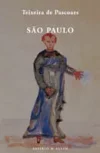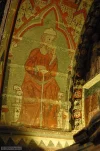Priscillian
Veteran Member
- Time of past OR future Camino
- Frances 1999, Aragones 2000, Desde Le Puy 2002, Portuguese 2009, hoping RDLP 2014
Dear Fellow Pilgrims,
I have just discovered this Forum and hope to add my comments whenever I can.
I walked my own Camino in 1999 from the Pyrennees. There is still no doubt in my mind that it was perhaps the most important thing I have ever done, and, as it does with all pilgrims remains a constant influence in my everyday life.
Along the way, somewhere between Ponferrada and Cacabelos, my fellow pilgrim, and a Gnostic priest, told me that there was incresing conjecture that it was not S. James buried in Compostela at all, but a "heretic" named Priscillian. I countered that I had never heard of Priscillian, but the idea wouldn't go away. So when I got back, I began to do a bit of research and what I found was fascinating indeed. Priscillian's story had all the elements of a best seller: persecution and injustice, alternative faiths, a scandal or two, but no such book existed. So I decided the only thing to do was write my own!
Pilgrimage to Heresy has been recently published in the US. It is "novel" in so much as the story and dialogue are my own, but, the historial detail, such as we know it, is accurate, and it presents Priscillian's philosophy dovetailed with the thoughts of Miranda, a modern day Canadian pilgrim, who is looking for the basis for her own beliefs and insights into her own spirituality. If you have walked the Camino, or plan to, I would be very surprised if you do not find something of yourselves within its pages.
For more information, see http://www.pilgrimagetoheresy.com where you can read about Priscillian, my own Camino, and some links to Gnosticism, as well as ordering information. You can also read some pages from the book.
If you wish to read the Prologue and the first chaper, see also http://www.iuniverse.com/lookinside/Loo ... 124&page=3
Ultreia y Buen Camino
Tracy Saunders
Spain
I have just discovered this Forum and hope to add my comments whenever I can.
I walked my own Camino in 1999 from the Pyrennees. There is still no doubt in my mind that it was perhaps the most important thing I have ever done, and, as it does with all pilgrims remains a constant influence in my everyday life.
Along the way, somewhere between Ponferrada and Cacabelos, my fellow pilgrim, and a Gnostic priest, told me that there was incresing conjecture that it was not S. James buried in Compostela at all, but a "heretic" named Priscillian. I countered that I had never heard of Priscillian, but the idea wouldn't go away. So when I got back, I began to do a bit of research and what I found was fascinating indeed. Priscillian's story had all the elements of a best seller: persecution and injustice, alternative faiths, a scandal or two, but no such book existed. So I decided the only thing to do was write my own!
Pilgrimage to Heresy has been recently published in the US. It is "novel" in so much as the story and dialogue are my own, but, the historial detail, such as we know it, is accurate, and it presents Priscillian's philosophy dovetailed with the thoughts of Miranda, a modern day Canadian pilgrim, who is looking for the basis for her own beliefs and insights into her own spirituality. If you have walked the Camino, or plan to, I would be very surprised if you do not find something of yourselves within its pages.
For more information, see http://www.pilgrimagetoheresy.com where you can read about Priscillian, my own Camino, and some links to Gnosticism, as well as ordering information. You can also read some pages from the book.
If you wish to read the Prologue and the first chaper, see also http://www.iuniverse.com/lookinside/Loo ... 124&page=3
Ultreia y Buen Camino
Tracy Saunders
Spain






















